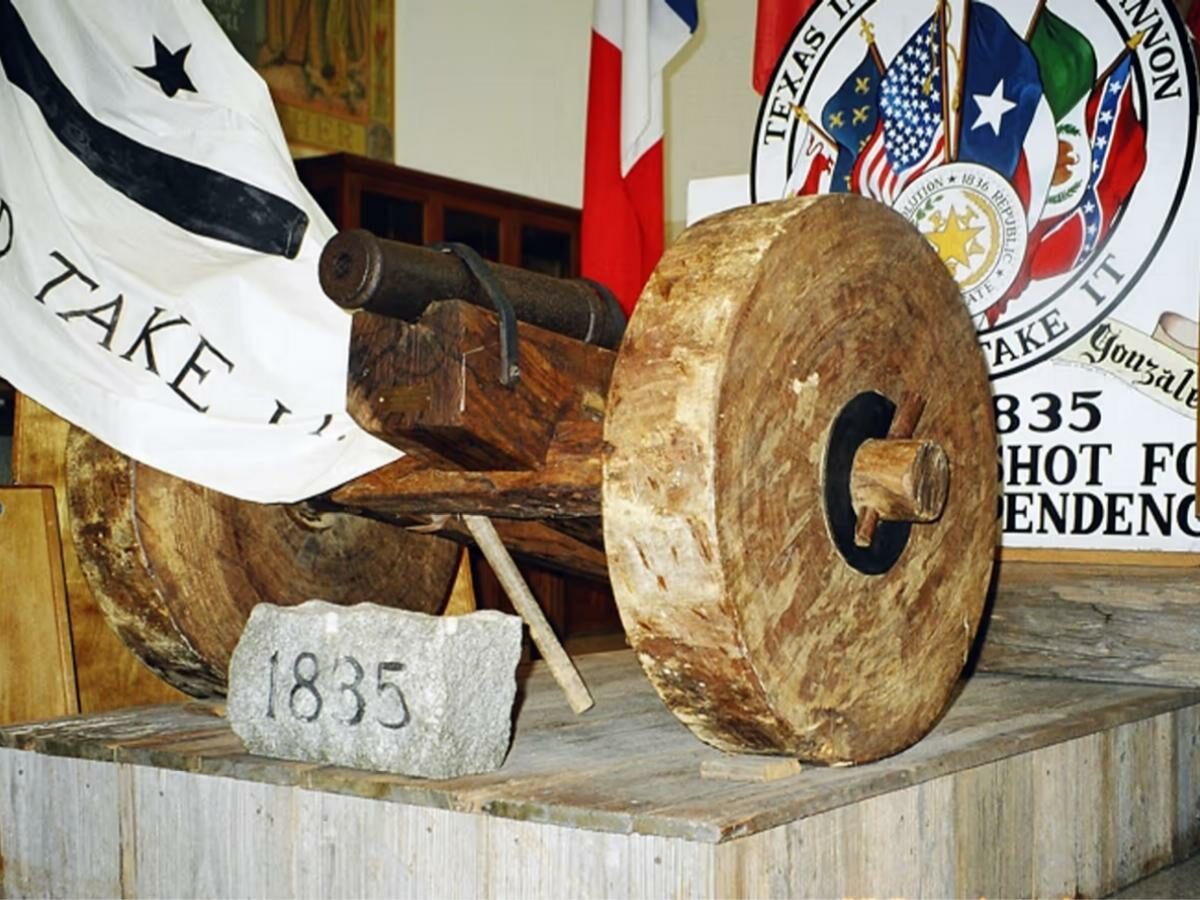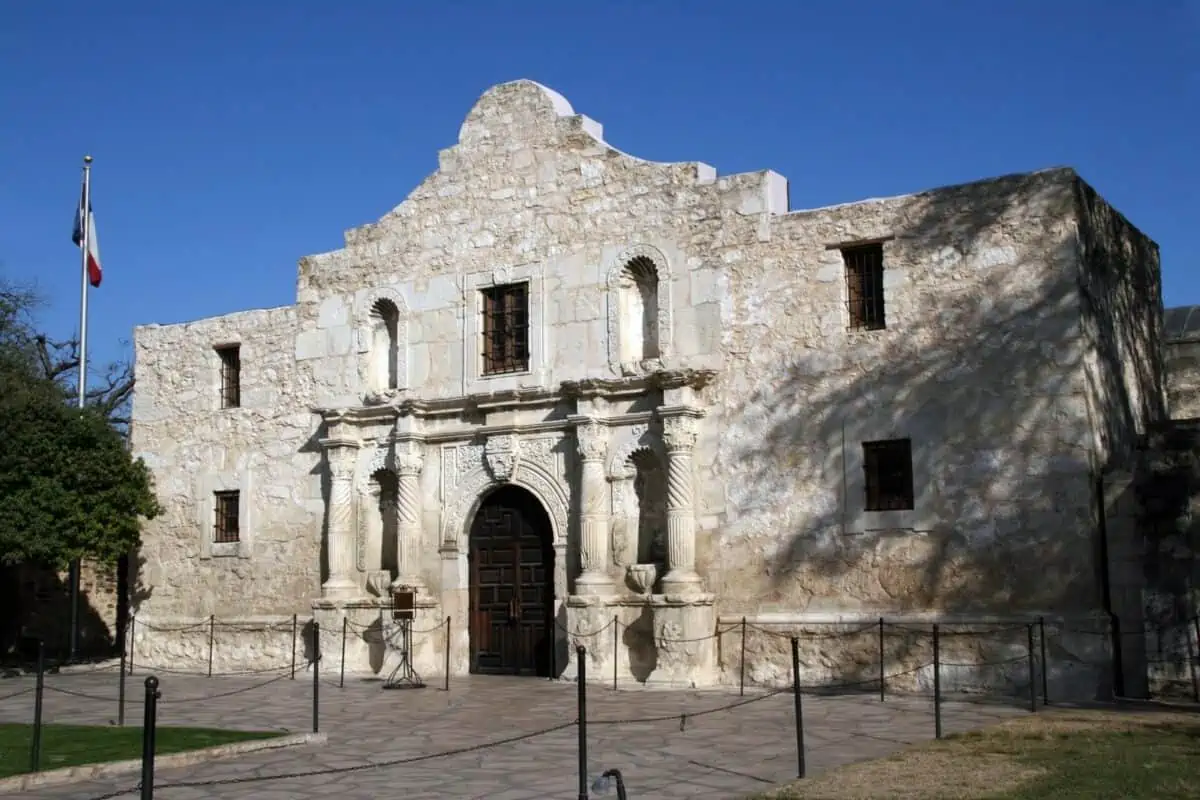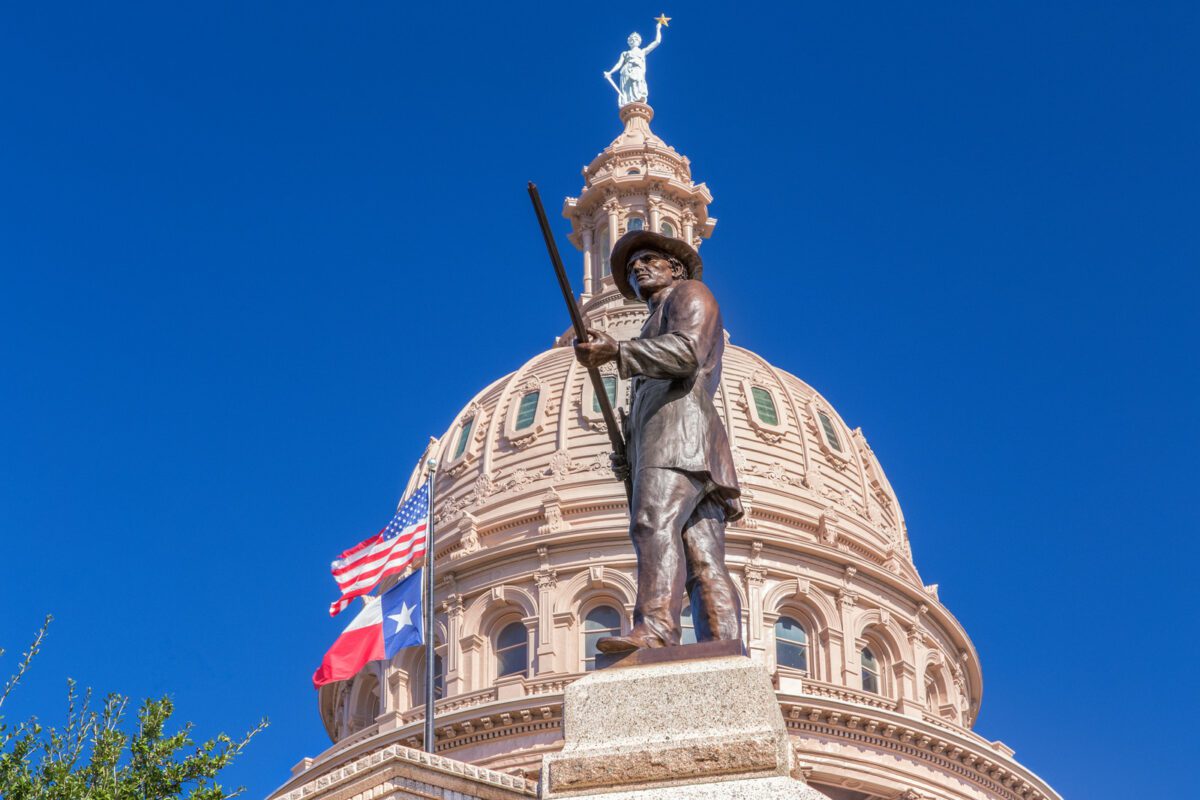One fascinating thing about the Lone Star State is that it’s the only U.S. state to have been a sovereign republic. Let’s explore how the “Come and Take It” incident put Texas on the evolutionary path from a Mexican colony, to an independent republic, to a U.S. state.
The phrase “Come and Take It” originates from the Battle of Gonzales, in which the people of Texas decided to defy the orders of the Mexican authorities. This battle was the spark plug that initiated the Texas Revolution.

What Is the Texas “Come and Take It” Flag?
The Texas “Come and Take It” flag is a white flag emblazoned with a black cannon. Above the cannon is a star, and below it is the phrase “Come and Take it.”
Although this flag is relatively simple, it’s incredibly rich with historical significance. It’s a totem of the events of the Battle of Gonzales that took place in 1835, almost two centuries ago. The flag symbolizes the Texans’ uprising against Mexican colonial rule.
To this day, the “Come and Take It” flag is a revered part of Texas’s lore and is proudly displayed by the state’s natives.
The Battle That Inspired the Flag
So, what exactly happened in the famed battle that birthed the “Come and Take It” flag? You may envision a full-fledged battle between the Texans and their Mexican oppressors.
In reality, you can more accurately describe the events of the Battle of Gonzales on October 2nd, 1835, as a scrap. To have context for what happened, you must first understand the circumstances of the months leading up to the Battle of Gonzales.
This period was rife with rising tensions between the Texans and Mexicans. Therefore, when the Mexican authorities sent their troops to bring back the cannon they had given the Texans as a line of defense against the Native Americans, the people of Texas weren’t ready to oblige.
Instead, they proceeded to take the Mexican troops as prisoners. This prompted the Mexican government to send 100 additional troops as reinforcement.
A battle broke out between those troops and the Texans, in which the latter used the cannon to fire two shots at the former to push them back.
Two Shots Fired!
In hindsight, the two shots fired from the cannon in the Battle of Gonzales were the first of many fired during what is now known as the Texas Revolution.
These shots set the state of Texas on the path toward the independence it had been struggling to achieve for so long. The events of the Battle of Gonzales were pivotal in transforming Texas into an independent republic and then a U.S. state.
As Sam Houston said during the revolution: “Texas will again lift its head and stand among the nations. It ought to do so, for no country can compare with it in natural advantages.” It did, indeed.
They also gave rise to the “Come and Take It” slogan, which refers to the Texans’ defiance against the Mexican soldiers who were sent to retrieve the cannon.
The “Come and Take It” flag was the idea of Eveline DeWit and Caroline Zumwalt. These two women created the flag and flew it above Gonzales during the famed battle.

Where Is the “Come and Take It” Cannon Now?
The cannon currently resides in the Gonzales Memorial Museum in Texas. The cannon itself is the same one the Texans used to stand their ground against their Mexican oppressors. However, the carriage it’s currently standing on is a replica.
An interesting tidbit you should know about is that part of the original cannon is now not a cannon at all. It’s been recast into a bell and is on display in the belfry of the Sy. Mark’s Episcopal Church in San Antonio.
How did this happen? After the cannon was buried inside the Alamo compound along with its other captured counterparts, it was dug up in 1852 by Samuel Maverick.
Following his death, his wife, Mary took the cannon to New York. This is where the cannon was recast.
How Is the “Come and Take It” Flag Used in Texas Today?
The “Come and Take It” motto will forever be etched into the fabric of Texan culture. The Texas State Capitol displays a replica of the “Come and Take It” flag.
The motto is especially dear to the hearts of the city of Gonzales itself. It’s etched onto a giant flag that flies over a square in the heart of downtown Gonzales. It’s also a staple of the city’s public employees’ uniforms.
However, extremists such as gun rights activists and anti-government groups have also used the flag to propagate their agenda.
The former has adopted the “Come and Take It” slogan and substituted the cannon for an AR-15 semiautomatic rifle. The latter group has used the flag, minus the AR-15, as a symbol of defiance against the federal government.
You can find such flags on full display by many Texans alongside the U.S. and Texas state flags. This has been met with much dismay by city officials and history buffs who feel like the true meaning of the “Come and Take It” slogan is being tainted.

“Come and Take it” FAQs
Here are some of the most commonly asked questions (and answers) about this fascinating tidbit of Texas lore.
1. What is another name for the “Come and Take It” flag?
The “Come and Take It” flag is also the Gonzales flag. This was created due to the battle between the Mexicans and the Texan rebel forces in Gonzales.
This battle sparked the Texas Revolution and has since been considered a symbol of defiance and independence.
2. What happened to the original “Come and Take It” flag?
The original “Come and Take It” flag was taken to the Alamo in San Antonio following the Battle of Gonzales. Unfortunately, the flag was ultimately lost.
A replica of it is on display in the Texas State Capitol today.
3. Were there any casualties in the Battle of Gonzales?
Despite having an enormous effect on Texas history, the Battle of Gonzales wasn’t as bloody as you may expect.
The casualties of the battle only included two deaths and one wounded soldier. The injured troop was from the Texan side. A kick to the face from a horse rendered his nose bloody.
4. Was the Battle of Gonzales the first time “Come and Take It” was used?
Although people often associate the phrase “Come and Take It” with the Battle of Gonzales, the 1835 skirmish isn’t the first time the slogan was used.
In 480 B.C. the Spartans bellowed the phrase during the Battle of Thermopylae. It was a statement of defiant objection to the Persian army’s demands for the Spartans to stand down.
The troops at Fort Morris also used this phrase during the American Revolution in 1778.
References
- Cannon recast as church bell: postcardsfromsanantonio.com
- “Come and take it” used by gun rights activists: npr.com
Christian Linden is a seasoned writer and contributor at Texas View, specializing in topics that resonate with the Texan community. With over a decade of experience in journalism, Christian brings a wealth of knowledge in local politics, culture, and lifestyle. He holds a Bachelor's degree in Communications from the University of Texas. When he's not writing, Christian enjoys spending weekends traveling across Texas with his family, exploring everything from bustling cities to serene landscapes.











